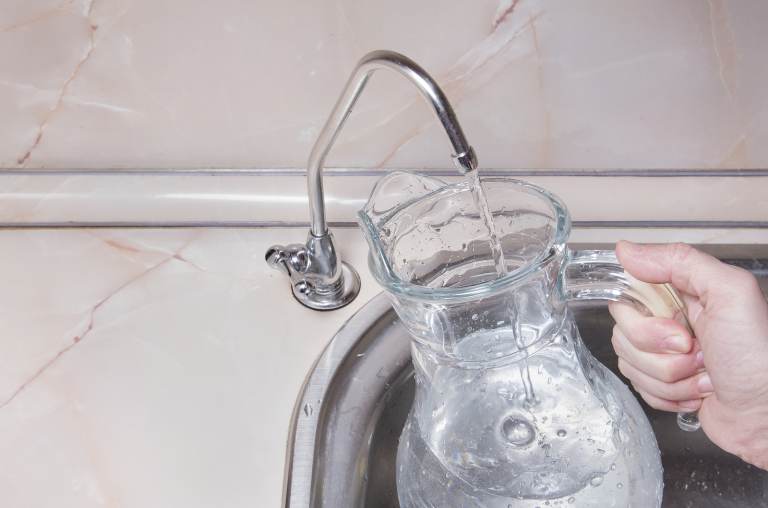What’s in the water? For many in Philadelphia’s suburbs, not fluoride. Why?
Philadelphia fluoridates its drinking water, but that’s not the case in many of the towns surrounding the city.

File photo: A number of projects are underway to remove PFAS, or 'forever chemicals', from the water in Montgomery County. (marina-tr/BigStock)
We wrote this story based on responses from readers and listeners like you. In Montgomery and Delaware counties, what do you wonder about the places, the people, and the culture that you want WHYY to investigate? Let us know here.
Updated July 7
If you’ve been to a dentist in the suburbs of Philadelphia, you may have heard complaints about the lack of fluoride in the drinking water. You may have even been sent home with toothpaste and mouthwash containing fluoride.
Philadelphia fluoridates its drinking water, but that’s not the case in many of the towns surrounding the city. Why?
Seems like a straightforward enough question, but it was surprisingly difficult to find an answer.
The science, and the history
Fluoride is a naturally occurring mineral found, to some extent, in all water. It strengthens teeth and, according to the Centers for Disease Control and Prevention, can prevent up to 25% of decay and ultimately block the formation of cavities in children and adults.
Fluoride’s beneficial effect on teeth was discovered more than 100 years ago.
“A dentist by the name of Fred McKay moved to Colorado Springs in the early part of the 20th century, and he noticed that his patients there had this very vivid, dark stain on their teeth. Local people said that it was caused by the water, but there has been nothing identified in the water supply that indicated why people would have such a dark stain,” said Catherine Carstairs, a professor of history at the University of Guelph in Ontario.
It turned out the residents of Colorado Springs, Colorado, weren’t the only ones with stained teeth. In fact, it was determined that this sort of thing was happening in a few other places and was caused by high amounts of fluoride.
By the 1930s, however, researchers had ascertained that lower levels of naturally occurring fluoride actually helped rebuild the surface of a tooth, the enamel.
“The idea developed that if you just added small amounts of fluoride to the water supply, you could bring about substantial changes, especially for children in terms of the numbers of cavities that they had,” Carstairs said.
In 1945, Grand Rapids, Michigan, became the first U.S. city to add fluoride to community drinking water. Slowly, but surely, more municipalities followed suit.
In 1999, the CDC declared the fluoridation of drinking water to be one of the 10 great public health achievements of the 20th century, alongside vaccines and the recognition that tobacco use was a health hazard.
By 2016, the CDC estimated that nearly 75% of people that were served by community water systems had access to fluoride.
The Philadelphia Water Department has been adding fluoride to the city’s drinking water since 1951. Initially, the concentration of fluoride was 1.0 milligrams per liter. That was lowered in 2012 to 0.7 milligrams per liter, at the recommendation of the U.S. Public Health Service.
“Community water fluoridation provides a consistent and optimized level of fluoride and is an inexpensive mechanism for providing its health benefits to all, regardless of age, income, education, or socioeconomic status,” a Water Department representative said in a statement to WHYY News. “Fluoridation has traditionally been justified on the economic basis of a 40 to 65% reduction in dental caries; for larger communities, the cost has been approximated at 50 cents per person to fluoridate water. The CDC estimates that in most cities, every $1 invested in water fluoridation yields an approximate $38 in savings on dental treatment costs.”
Unfluoridated in much of the suburbs
By contrast, residents of neither Montgomery County nor Delaware County are served by a single publicly owned water utility.
In Montco alone, there are nearly 40 independent water systems, and of that number, according to a county representative, 15 to 17 would be considered major community purveyors. That includes municipally managed systems such as the Ambler Borough Water Department and the Horsham Water & Sewer Authority, as well as private-sector operators such as Aqua Pennsylvania and Pennsylvania American Water.
“Aqua PA is the only water purveyor now that provides some fluoridated water,” the Montgomery County spokesperson, Kelly Cofrancisco, said.
Aqua, which has a shared main service division that stretches across heavily populated areas of both Montgomery and Delaware counties, said it does not have a stance on water fluoridation.
“We do not add fluoride to the majority of the water we serve in Southeastern Pennsylvania. The Pennsylvania Department of Environmental Protection, which regulates water systems, doesn’t require fluoride in drinking water, and our position is that the decision whether or not to fluoridate is one of public policy,” Aqua PA representative Gretchen Toner said in a statement. “However, we appreciate that there are a variety of opinions on fluoride in drinking water.”
Aqua fluoridates water at some of the systems it serves, but Toner said that’s only at the direction of community leaders.
“We fluoridate the water at these plants as a continuation of a decision made by the local governments before the systems were sold to us, and because fluoride is currently included in these operating permits. If all municipalities served by our system were to convene and agree that they wanted fluoridated water, Aqua would consider it,” Toner said.
Pennsylvania American Water Co., which serves Norristown, has a similar position on water fluoridation being a community decision.
WHYY News reached out to several municipally owned water systems, including the Pottstown Borough Water Authority, the Ambler Borough Water Department, and the Horsham Water & Sewer Authority — all of which had previously fluoridated water — to see why they changed their minds. Though they offered answers affirming their fluoridation status, none of the municipal water systems contacted provided a reason for the switch.
Delaware County has fewer major water purveyors than Montco does, but the story is largely the same there: minimal fluoridation.
WHYY News reached out several times to both the City of Chester and the Chester Water Authority to see why it remains the lone community-owned system in the two counties to fluoridate water, but a response was not received.
Suez Water also offers fluoridated water, in Delco’s Bethel Township.
Residents of Delaware and Montgomery counties who are unsure of the fluoridation status of their water should contact their suppliers or local officials.
Dentists endorse fluoridation
Though local officials were unexpectedly quiet, Pennsylvania dentists were more than willing to speak on the topic. Community water fluoridation is on the decline beyond Philadelphia’s collar counties, some dentists said.
Mechanicsburg, in central Pennsylvania, was recently the epicenter of a community battle to keep fluoride in the water. Supporters of the practice, like Dr. Jeff Alba, were on the losing end.
“Pennsylvania, historically, has been pretty poor with its water fluoridation statewide. I would say maybe 50% of Pennsylvania’s public water is fluoridated. And it’s been trending downward,” said Alba, an orthodontist.
According to the CDC, Pennsylvania ranked 42nd in water fluoridation in 2018, the latest information available.
Even though he doesn’t solely place the blame on their shoulders, Alba believes that a lot of this has to do with the growing involvement of private companies in providing water service.
“It feels like it’s a financial decision. They’re seeing what that cost to them per year is to provide it to the community, and it’s getting cut,” Alba said.
He noted that even though dentists stand to benefit the most financially from the decline of fluoride in public drinking water, dentists are the ones sounding the alarm.
In the Lancaster area, Dr. Tom Regan, a retired general dentist, characterized fluoride as a miracle in dental health. But several years ago, Regan went through the same fight In Quarryville that Alba experienced in Mechanicsburg. He lost, too.
“When we lost, it was a very close call … you know, it was a 3 to 2 vote in the water authority to get rid of the fluoride,” Regan said.
Though he couldn’t draw definitive conclusions on the decision’s effect, Regan said he noticed differences.
“All of my colleagues in town could definitely tell people who did not live in the borough or have borough water,” Regan said.
He pointed to a 2018 University of Alaska study that looked into the 2007 cessation of water fluoride in Juneau, Alaska, and its effects on children.
Researchers found evidence that the age group with the most dental procedures were born after the stoppage of water fluoridation. Despite the high costs to the community, the city has no plans to reintroduce fluoride.
For those who work in community health centers, like Dr. Donald Chi, a professor of dentistry and public health at the University of Washington in Seattle, fluoride has been an invaluable tool to help prevent tooth decay in children from low-income communities.
Fluoridation rates in Seattle have remained stable, according to Chi, but that hasn’t stopped him from looking at what could happen if the area were to follow in the footsteps of Juneau. Chi thinks a variety of things are spurring the reluctance to continue to fluoride water.
“I think that there is … kind of a desire to want to have a choice. And then I think there are … families and parents, community members who may be concerned about the safety of fluoride. We know, based on the evidence that fluoride is, it’s natural, and it’s safe,” Chi said.
Over the years, there have been studies and debate among scientists about whether fluoridation poses a risk of a rare form of cancer. However, more recent studies do not find an association between the two.
In 2016, a group of nonprofits and individuals petitioned the Environmental Protection Agency to end the addition of fluoride to drinking water under the Toxic Substances Control Act, which authorizes the agency to regulate and screen chemicals to prevent unreasonable risks to health and the environment. The EPA denied the petition, and the groups, citing neurotoxicity issues, sued in federal court. A ruling in the case is pending.
With the explosion of sugary drinks in the fast-food age, Chi said, fluoride is still necessary. Children across the socioeconomic spectrum are being affected by cavities.
“In fact, it’s not unusual to see children these days who come from very, very wealthy families, who will come in and come in with a mouthful of cavities that needs to be fixed,” Chi said.
He added that he has conversations with parents all the time about their valid concerns about the option to treat their children’s teeth with fluoride. These talks are not only necessary, he said, but also can serve as a teaching moment for public health researchers such as himself.

Get daily updates from WHYY News!
WHYY is your source for fact-based, in-depth journalism and information. As a nonprofit organization, we rely on financial support from readers like you. Please give today.







